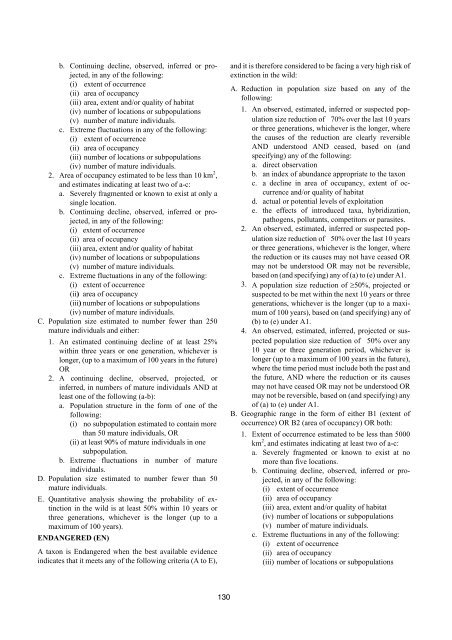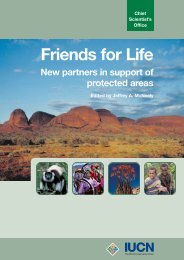Dolphins, Whales and Porpoises: 2002-2010 Conservation - IUCN
Dolphins, Whales and Porpoises: 2002-2010 Conservation - IUCN
Dolphins, Whales and Porpoises: 2002-2010 Conservation - IUCN
Create successful ePaper yourself
Turn your PDF publications into a flip-book with our unique Google optimized e-Paper software.
. Continuing decline, observed, inferred or projected,<br />
in any of the following:<br />
(i) extent of occurrence<br />
(ii) area of occupancy<br />
(iii) area, extent <strong>and</strong>/or quality of habitat<br />
(iv) number of locations or subpopulations<br />
(v) number of mature individuals.<br />
c. Extreme fluctuations in any of the following:<br />
(i) extent of occurrence<br />
(ii) area of occupancy<br />
(iii) number of locations or subpopulations<br />
(iv) number of mature individuals.<br />
2. Area of occupancy estimated to be less than 10 km 2 ,<br />
<strong>and</strong> estimates indicating at least two of a-c:<br />
a. Severely fragmented or known to exist at only a<br />
single location.<br />
b. Continuing decline, observed, inferred or projected,<br />
in any of the following:<br />
(i) extent of occurrence<br />
(ii) area of occupancy<br />
(iii) area, extent <strong>and</strong>/or quality of habitat<br />
(iv) number of locations or subpopulations<br />
(v) number of mature individuals.<br />
c. Extreme fluctuations in any of the following:<br />
(i) extent of occurrence<br />
(ii) area of occupancy<br />
(iii) number of locations or subpopulations<br />
(iv) number of mature individuals.<br />
C. Population size estimated to number fewer than 250<br />
mature individuals <strong>and</strong> either:<br />
1. An estimated continuing decline of at least 25%<br />
within three years or one generation, whichever is<br />
longer, (up to a maximum of 100 years in the future)<br />
OR<br />
2. A continuing decline, observed, projected, or<br />
inferred, in numbers of mature individuals AND at<br />
least one of the following (a-b):<br />
a. Population structure in the form of one of the<br />
following:<br />
(i) no subpopulation estimated to contain more<br />
than 50 mature individuals, OR<br />
(ii) at least 90% of mature individuals in one<br />
subpopulation.<br />
b. Extreme fluctuations in number of mature<br />
individuals.<br />
D. Population size estimated to number fewer than 50<br />
mature individuals.<br />
E. Quantitative analysis showing the probability of extinction<br />
in the wild is at least 50% within 10 years or<br />
three generations, whichever is the longer (up to a<br />
maximum of 100 years).<br />
ENDANGERED (EN)<br />
A taxon is Endangered when the best available evidence<br />
indicates that it meets any of the following criteria (A to E),<br />
130<br />
<strong>and</strong> it is therefore considered to be facing a very high risk of<br />
extinction in the wild:<br />
A. Reduction in population size based on any of the<br />
following:<br />
1. An observed, estimated, inferred or suspected population<br />
size reduction of � 70% over the last 10 years<br />
or three generations, whichever is the longer, where<br />
the causes of the reduction are clearly reversible<br />
AND understood AND ceased, based on (<strong>and</strong><br />
specifying) any of the following:<br />
a. direct observation<br />
b. an index of abundance appropriate to the taxon<br />
c. a decline in area of occupancy, extent of occurrence<br />
<strong>and</strong>/or quality of habitat<br />
d. actual or potential levels of exploitation<br />
e. the effects of introduced taxa, hybridization,<br />
pathogens, pollutants, competitors or parasites.<br />
2. An observed, estimated, inferred or suspected population<br />
size reduction of � 50% over the last 10 years<br />
or three generations, whichever is the longer, where<br />
the reduction or its causes may not have ceased OR<br />
may not be understood OR may not be reversible,<br />
based on (<strong>and</strong> specifying) any of (a) to (e) under A1.<br />
3. A population size reduction of �50%, projected or<br />
suspected to be met within the next 10 years or three<br />
generations, whichever is the longer (up to a maximum<br />
of 100 years), based on (<strong>and</strong> specifying) any of<br />
(b) to (e) under A1.<br />
4. An observed, estimated, inferred, projected or suspected<br />
population size reduction of � 50% over any<br />
10 year or three generation period, whichever is<br />
longer (up to a maximum of 100 years in the future),<br />
where the time period must include both the past <strong>and</strong><br />
the future, AND where the reduction or its causes<br />
may not have ceased OR may not be understood OR<br />
may not be reversible, based on (<strong>and</strong> specifying) any<br />
of (a) to (e) under A1.<br />
B. Geographic range in the form of either B1 (extent of<br />
occurrence) OR B2 (area of occupancy) OR both:<br />
1. Extent of occurrence estimated to be less than 5000<br />
km 2 , <strong>and</strong> estimates indicating at least two of a-c:<br />
a. Severely fragmented or known to exist at no<br />
more than five locations.<br />
b. Continuing decline, observed, inferred or projected,<br />
in any of the following:<br />
(i) extent of occurrence<br />
(ii) area of occupancy<br />
(iii) area, extent <strong>and</strong>/or quality of habitat<br />
(iv) number of locations or subpopulations<br />
(v) number of mature individuals.<br />
c. Extreme fluctuations in any of the following:<br />
(i) extent of occurrence<br />
(ii) area of occupancy<br />
(iii) number of locations or subpopulations






